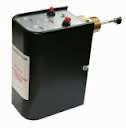Last week I discussed how to check the mechanical low-water
cutoff on your steam boiler. However, more and more new steam boilers are
equipped with “probe-type” low-water cutoffs that use an entirely different
mechanism to detect a low-water condition and shut down your burner before an
unsafe condition occurs. (For more on that, see this post on the evolution of
the low-water cutoff control.)
The typical probe-type low-water cutoff is threaded into a
port on your steam boiler provided by the boiler manufacturer
specifically for this purpose. It’s below the normal water level but just above
the level of the bottom sight-glass port. This type of low-water cutoff
operates by monitoring the electrical continuity of the boiler water. Simply
put, when the probe is exposed to water, it allows the burner to operate. And
when it’s exposed to air (as in a low-water condition) it does not.
 |
| McDonnell & Miller PSE-800 |
Some probe-type low-water cutoffs allow the burner to operate
for a little bit after they sense a low-water condition — usually about 30
seconds. This is to prevent nuisance shutdowns due to temporary conditions,
such as foaming or slow return of system condensate. A flashing light on the low-water
cutoff control enclosure usually indicates this type of condition. If the probe
senses water again within the 30-second window, the light will stop flashing
and the burner continue firing without interruption.
Probe-type low-water cutoffs are either manually or automatically
reset. Most residential steam boilers use automatic reset to let the boiler
continue heating once the low-water condition is corrected — as when an
automatic water feeder is used. A manual reset would require human intervention
— a strategy that may not be in your best interest if the boiler were to shut
down on low water when you’re away for a few days during the winter.
With either type, you can periodically check the device’s
electronics by pressing and holding the test button while the burner is firing.
A light will usually flash for a period of time and then the burner will shut
down. Releasing the test button should start the burner and return the system
to normal operation.
A probe-type low-water cutoff doesn’t require the same
weekly maintenance as its mechanical cousin. But during the annual maintenance
of your system, I’ll check your cutoff by lowering the water level to simulate
an actual low-water condition. And every five years, I’ll remove the probe for
cleaning and inspection. If your probe is older than 10 years, I should replace
it for you.
With just a little attention, your probe-type low-water cutoff
should provide years of reliable protection for your steam heating system.
Heidronically yours,
Wayne

If you need help with your home’s heating, cooling or hot water, we’re here for you 24/7...
ReplyDeleteHeating and Cooling Mississauga
I was surfing net and fortunately came across this site and found very interesting stuff here. Its really fun to read. I enjoyed a lot. Thanks for sharing this wonderful information. boiler repair calgary
ReplyDeleteGreat insights on the "probe-type low-water cutoff" for steam boilers! It's crucial to understand its function in preventing unsafe conditions. Regular checks and maintenance can ensure years of reliable protection for your system.
ReplyDelete